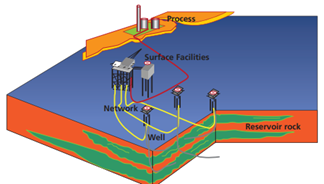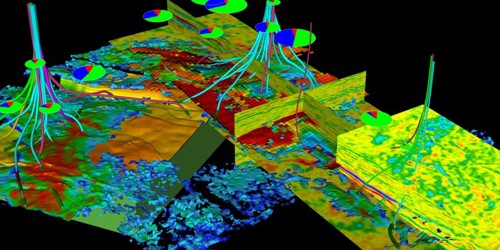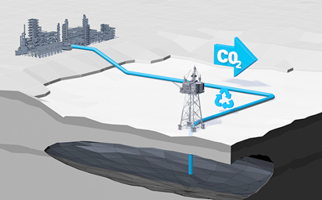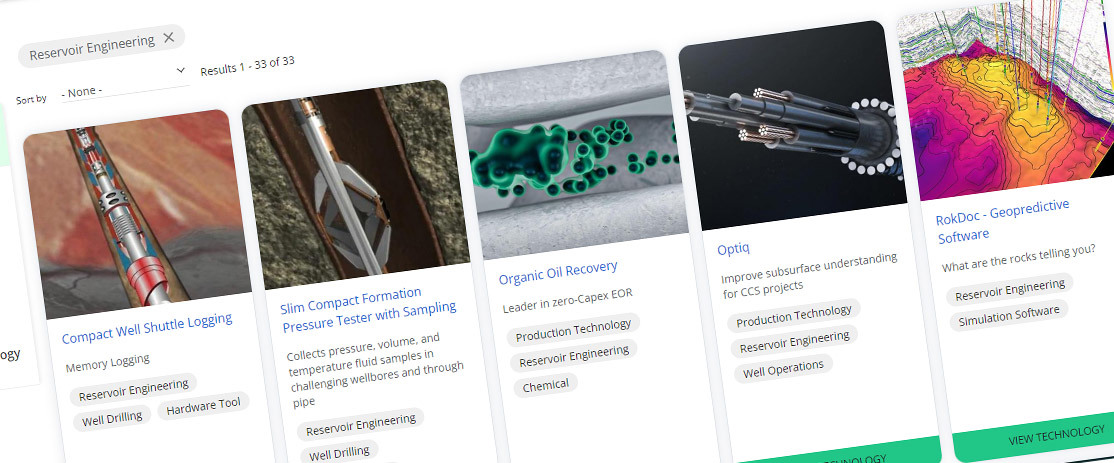Digital technologies have an increasingly strong presence in operators’ technology plans, with 28 out of the 46 operators reporting technology targets in this category. This is also a trend that has seen continuous growth since the Technology Insights publication began.
Cloud data management and advanced analytics, including machine learning, have been successfully introduced to better exploit existing reserves.
“Connected Worker” technologies enable on-site crews to exchange technical and inspection data in real-time in the field via mobile networks using ATEX rated tablets and head-up displays and this technology is becoming business-as-usual.
Remote and non-intrusive inspection techniques combined with airborne drone and robotic crawlers to provide remote data collection and monitoring systems which are critical for successful asset management strategies such as in predictive maintenance, removing the need for some offshore manned operations, and reducing manned hazardous area/confined space entries.
Digital and data technologies
Digital and data applications are one of the strongest areas of interest according to operators’ technology plans, with 614 technologies submitted this year, an increase of 45% on 2024’s total.
There is broad industry participation, with 28 operators (61% of total respondents) having reported interest in digital technologies.
Digital and data is defined in this document as a ‘cross-cutting’ category, in which digital and data are integral parts of technology solutions in most areas of the offshore asset lifecycle (chart below).
Thirty-five percent of digital and data technologies in operators’ plans are still under development, which shows a good pipeline of new technology coming through, but the balance of 65% of proven technology shows this is a well-established area of UKCS technologies.
Whilst the majority of technologies are provided and deployed by vendors and suppliers, in 43% of cases operators take an active role in the development or customisation of the solutions for their assets’ needs
Readiness definitions: Early development (TRL 1-4), late development/pilot (TRL 5-7), early commercialisation (TRL 8), proven (TRL 9)
Operators continue to adopt "Connected Worker" technologies to enable on-site workers to communicate, receive and record data in the field via mobile networks, however these are reported less this year as they become business-as-usual. Onshore and offshore control rooms enable remote operations and along with technologies such as video sharing and high-speed internet connections help reduce offshore manning. No new technologies were reported this year.
- Video sharing during air diving for mooring chain changeout: Video system installed onto the FPSO turret along with a telemetry system to send the video feed to receiving telemetry systems on the DSV and AHT. This allowed real time footage from underwater cameras within the turret to be viewed by all parties.
- TRL 9 commercially available
- TRL 9 commercially available
- 4G installation: Creating a network offshore to enable mobile working and more telemetry to be streamed onshore. 4G LTE to follow.
- TRL 9 commercially available
- TRL 9 commercially available
- Digitalised logistics: Track and trace, digitalised logistics, end to end solution for automating the logistics process using hand-held devices and barcoding. Developed in close collaboration with Asco and DAI in Aberdeen.
- TRL 9 commercially available
New deployable technologies reported this year include integrity scanning for risers using a pipe scanner and a subsea crawler, sonic logging for locating top of cement across 9-5/8” casing, LoRaWAN network of long-life wireless pressure instruments in wellbay annuli. Emerging technologies include DAS micro seismic events logging, surface DAS for 3D reservoir imaging, through tubing cement bond logging (CBL), 3D handheld laser scanners, seabed digital acoustic sensing (S-DAS) for carbon storage sites, and multi-string thru tubing CBL.
- Methane measurement deployment: NZTC project on methane measurement deployment involving measurement of methane emissions from unburnt fuel gas, unburnt flare gas, venting and fugitives.
- TRL 9 commercially available (NEW)
- TRL 9 commercially available (NEW)
- Integrity scanning for risers: Integrity scanning for risers using crawlers.
- TRL 9 commercially available (NEW)
- TRL 9 commercially available (NEW)
- Emissions monitoring software: For flaring and crude arrivals.
- TRL 9 commercially available (NEW)
- TRL 9 commercially available (NEW)
- Downhole fibres/gauges DTS: Flow Indication for each zone in a DST using downhole temperature sensors to avoid the need for a PLT, reducing further emissions.
- TRL 9 commercially available (NEW)
- TRL 9 commercially available (NEW)
- Sonic logging: LWD sonic tool to log across 9 5/8" casing for top of cement identification after well encountered severe losses during a cementing job. Reduces the uncertainty in top of cement measurement.
- TRL 9 commercially available (NEW)
- TRL 9 commercially available (NEW)
- Compact sensors - Long Range Wide Area Network (LoRaWAN) sensors: Installation of a LoRaWAN network to enable installation of wireless long battery life wireless pressure instruments to replace existing pressure gauges on wellbay annuli.
- TRL 9 commercially available (NEW)
- TRL 9 commercially available (NEW)
The SoundTrak™ service employs proprietary acoustic technology to directly measure valid formation slowness. Multi-frequency excitation ensures high data quality in both fast and slow formations, as well as in a wide range of hole sizes. These measurements can be used for a variety of real-time and post-well applications.

- Hand-held laser scanner: Allowing the offshore team to complete 3D point cloud scans where and when required to significantly increase the productivity and efficiency of maintenance and modifications projects, especially when linked to a digital twin.
- TRL 9 commercially available
- DAS micro seismic events: Recorded at seabed including automatic detection of events, processing algorithm development and tests.
- TRL 1-4 early development (NEW)
- TRL 1-4 early development (NEW)
- Surface DAS: Fibre optic for 3D reservoir imaging.
- TRL 1-4 early development (NEW)
- TRL 1-4 early development (NEW)
- Through tubing CBL and casing wear logging: To verify appropriate annular barriers through multiple tubing / casing strings.
- TRL 5-7 late development/pilot
- TRL 5-7 late development/pilot
- Seabed digital acoustic sensing (S-DAS) for carbon storage sites.
- TRL 5-7 late development/pilot
- TRL 5-7 late development/pilot
- Inventory optimisation: Automated inventory optimisation and reporting tool.
- TRL 1-4 early development
- TRL 1-4 early development
- Automating remote visual inspection: To reduce time to complete visual inspection, increase data quality and reduce human exposure due to lower offshore POB. Fully automated remote visual inspection by utilising point cloud data.
- TRL 1-4 early development
Operators reported deployable technologies such as open data including a consolidated geoscience data platform in the cloud. Emerging technology reported this year includes the Offshore Energy Data Trust to enable industry to share data. New this year are a digital planning and execution database, an emissions recording and reporting system and a real-time data project covering production chemistry and well performance.
- Interventions specific digital planning and execution database: To be used in the planning and execution of all well intervention scopes. Beyond just digital procedures, this digital database would store all jobs data to allow for a global database of performance KPIs, best practices, etc., without requiring the level of user input currently required.
- TRL 9 commercially available (NEW)
- TRL 9 commercially available (NEW)
- Emissions project: Further development of system to enhance emissions recording and reporting capabilities.
- TRL 9 commercially available (NEW)
- TRL 9 commercially available (NEW)
- Real-time data project: Covering production chemistry and well performance.
- TRL 9 commercially available (NEW)
- TRL 9 commercially available (NEW)
- Open data industry project for OSDU: Consolidated geoscience data platform within the cloud.
- TRL 9 commercially available
- TRL 9 commercially available
- Improved data search and classification: Flare MiNDR - Enhanced identified tagging, tracking and reporting of well information at well and field level.
- TRL 9 commercially available
- TRL 9 commercially available
- Digital integrated operations: Multiple technology deployments under a digital programme comprising integrated operations centres, IoT, mobility and data and analytics streams to improve efficiency and effectiveness of offshore operations.
- TRL 9 commercially available
- TRL 9 commercially available
- Asset integrity management database: Offshore/onshore electronic manipulation of inspection data.
- TRL 5-7 late development/pilot
- Offshore energy data trust: To enable industry data sharing. Target 10% reduction in risk exposure through utilisation of a data trust.
- TRL 5-7 late development/pilot
- TRL 5-7 late development/pilot
- Check in process: Resulting in a reduction in check in time including cascading flight and safety information to passengers. Allows passengers access to their personal details, training competencies, trip history and to receive electronic messaging on flight details.
- TRL 5-7 late development/pilot
- TRL 5-7 late development/pilot
- Flexible integrity assurance: A standard fitness for service methodology for flexible pipes.
- TRL 1-4 early development
This sub-category includes advanced timelapse 4D seismic data processing techniques, depo gridding, subsurface illumination, subsurface modelling to better exploit existing reserves and locate missed pay opportunities, and adoption of AI/machine learning in subsurface modelling. Novel processing methods including depth dependant seismic facies inversion, and subsurface modelling for CO2 storage. New this year are seismicity monitoring system design, waste-heat recovery unit simulation modelling, and software plug-ins to improve production forecasting. Emerging technologies include proprietary miniature methane sensors, and machine learning for detection of micro seismic events from antenna recordings.
- Dynamic simulation modelling of Waste Heat Recovery Unit (WHRU) and its control loop to enhance the control tuning, prior to implementation of upgrade to remove a long-standing issue and enhance/reduce commissioning time for the system. Includes process safety impact to ensure dangerous operation cannot occur and CFD modelling of gas turbine purge sequence to validate time required to sufficiently inert the exhaust prior to firing.
- TRL 9 commercially available (NEW)
- TRL 9 commercially available (NEW)
- Multiphysics petrel plugin: To improve production forecasts from reservoir simulators, more accurately locate the remaining oil, and de-risk infill drilling opportunities.
- TRL 8 early commercialisation (NEW)
- TRL 8 early commercialisation (NEW)
- Depo gridding: Trial using unstructured depogrids to model reservoirs, while honouring complex geological structures and layering more accurately than standard geocellular models. Can be used in a next generation simulator.
- TRL 9 commercially available
- TRL 9 commercially available
- Subsurface illumination: Enables 3D visualisation of the subsurface while drilling and delivers automated high- resolution models in real time.
- TRL 9 commercially available
- TRL 9 commercially available
- Advanced self-service analytics: An advanced analytics tool to improve automation and provide engineering-based modelling and machine learning capabilities.
- TRL 9 commercially available (NEW)
- TRL 9 commercially available (NEW)
- Depth-dependent seismic facies inversion: Pre-stack simultaneous facies modelling.
- TRL 9 commercially available
- Proprietary miniaturised methane sensor: Provides high resolution for leak grading. Paired with software suite and custom algorithms the self-contained and field-proven package offers localised, quantified emissions data.
- TRL 5-7 late development/pilot (NEW)
- TRL 5-7 late development/pilot (NEW)
- Machine learning for detection: And extraction of micro seismic events from antenna recordings.
- TRL 5-7 late development/pilot (NEW)
- Subsurface CO2 storage assessment: Subsurface modelling with potential for new data acquisition and processing to allow modelling of CO2 injectivity, migration within the reservoir and containment of the CO2 subsurface.
- TRL 1-4 early development
Operators report use of software driven solutions for production optimisation, smart monitoring for ESPs, and oncoming crew fatigue assessment apps. Emerging technology includes a drill bit collision assessment software for areas of high well density/positional uncertainty. New this year are an AI-based automatic warehousing reporting tool, an AI-based multi software/activity integration work execution package and a lifting equipment management system.
- AI-based automatic warehousing: Reporting tool for production, HSE and operational data that supersedes PowerBI.
- TRL 9 commercially available (NEW)
- TRL 9 commercially available (NEW)
- Proprietary software combining three systems currently in use: To improve site execution efficiency. To change how to get work into activity schedules and how to manage work execution. Tool combines data from the core systems such as SAP and Primavera to provide users with an integrated view of what's needed to execute and performance manage work at site.
- TRL 9 commercially available (NEW)
- TRL 9 commercially available (NEW)
- Rigging loft management system: Software management system designed to track, monitor and assist with control and inspection of all lifting equipment.
- TRL 9 commercially available (NEW)
- TRL 9 commercially available (NEW)
- Improved production optimisation: Use of integrated production modelling (IPM) software composed of three packages to optimise production in the field area.
- TRL 9 commercially available
The concept of Integrated Production Modelling (IPM) was pioneered by Petroleum Experts and it involves the elimination of artificial boundary conditions. A change that is made on a pipeline model for example, will automatically change the behaviour of the wells and reservoirs upstream of that pipe, as well as behaviour of all the elements downstream.

- Smart monitoring for electrical submersible pumps ESP: Condition-based monitoring and automatic optimisation of ESPs in wells.
- TRL 9 commercially available
- TRL 9 commercially available
- Fatigue assessment app: Application for supervisors to assess the fatigue of new crew coming on shift.
- TRL 9 commercially available
- Reduce/eliminate risk of drilling collision issues caused by high well density and positional uncertainties plans: Technical and commercial review of "at bit collision detection". Failure to mitigate collision risk may reduce field ultimate recovery because some wells targets will be un-drillable or EOR injectors may be positioned sub optimally.
- TRL 5-7 late development/pilot
Operators report use of digital technologies that enhance the ability to remotely monitor or inspect offshore assets, improve the assessment and tracking of anomalies, and deliver augmented reality from ROVs for subsea wellhead, tubing hanger, and tree installation alignment. Also reported are integrity management software and thermographic camera surveys to detect passing valves. Emerging technologies include AI-assisted decision making for well P&A, a plant availability tool, and UAV data conversion and integration. New this year are robotic crawlers for internal visual inspections of J-tubes, dashboarding software, through tubing CBL, PI Vision consolidation, and 4D visualisation and integration software.
- UK PI vision consolidation: Development of new screens to provide standardised visualisation for all process machinery and wells across all assets.
- TRL 9 commercially available (NEW)
- TRL 9 commercially available (NEW)
- J-Tube survey by robotic crawler: Digital pan and tilt colour camera coupled with a crawler system. Visual inspection system for internal survey searching for weld defects and wall dents within a vertical J-Tube.
- TRL 9 commercially available (NEW)
- TRL 9 commercially available (NEW)
- UAV data conversion and integration: Use of orthomosaic techniques on higher resolution images to enable more structured integrity management. Gives the ability to do time-based reviews by comparing side by side images of the same area.
- TRL 9 commercially available
- TRL 9 commercially available
- Camera surveys - Passing valves: Thermographic setting on cameras used to indicate where valves on flare and vents may be passing. Existing technology but a new use for it.
- TRL 9 commercially available
- TRL 9 commercially available
- Anomaly assessment and tracking: Provides end-to-end traceability and reduces the amount of duplication in the current process.
- TRL 9 commercially available
- TRL 9 commercially available
- 4D Visualisation and Integration: Tools for optimally visualising 4D or testing.
- TRL 9 commercially available (NEW)
CoViz 4D makes it possible for multi-disciplinary asset teams to simultaneously view and interrogate all available data from seismic to simulation, regardless of the original data source.

- Through tubing CBL: Through tubing CBL to confirm TOC for casing strings. This could be performed to confirm TOC and/or presence of squeezing shales for future abandonment campaign planning.
- TRL 8 early commercialisation (NEW)
- TRL 8 early commercialisation (NEW)
- Data management system: Caissons database with improved comparative visualisation of integrity status.
- TRL 8 early commercialisation
- AI assisted decision making for well P&A: Software to aid decision making.
- TRL 5-7 late development/pilot
- TRL 5-7 late development/pilot
- Plant availability diagram: Equipment/system availability status tool which shows what's available/operational in real time.
- TRL 5-7 late development/pilot
- TRL 5-7 late development/pilot
- ROV augmented reality: For subsea wellhead, tubing hanger and tree installation alignment.
- TRL 5-7 late development/pilot
- TRL 5-7 late development/pilot
- Inspection robot: An autonomous fabric maintenance robotic solution, utilising latest AI, machine vision and machine learning.
- TRL 1-4 early development









